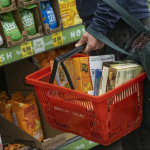In the News
February 25, 2025
Gobsmacked by groceries, Inflation inching higher for Washington consumers weary at the market

The Spokesman Review highlights both the national trends of food costs, as well as Washington state trends, pointing to a report released in February from the Washington State Food Security Surveys, showing that state residents continue to worry about food prices.
UW, WSU study shows WA residents struggling to pay for one particular monthly expense

This article by the Bellingham Herald highlights findings from the fifth edition of the Washington State Food Security Survey released on Feb. 13, revealing a potential rise in food insecurity in Washington.
Grocery prices are a top financial worry, WA residents say

The Seattle Times looks at the growing high cost of food for Washington households, citing a state-wide survey conducted by UW Food Systems researchers called WAFOOD. FSNH faculty member Marie Spiker is quoted, “Of all the indicators that we have of how are households doing financially, food insecurity is a really important one, because it…
January 8, 2025
Autumn 2024 marks highest demand in UW Food Pantry history

UW Food Pantry donations for fall quarter of 2024 included 12% of donations from food drives, 11% from individual donations, and 15 to 20% came from on-campus dining facilities. Through work conducted by student capstone teams in winter 2024, the Pantry gleans unused food from UW in order to increase sustainability in providing resources to…
December 11, 2024
Mayor Harrell Releases Updated “Food Action Plan” to Guide City Policies and Programs, Increase Food Security in Seattle

Yona Sipos, core faculty in the Food Systems, Nutrition, and Health program is quoted in this recent post by the City of Seattle Mayor’s office, remarking, “The recently updated plan provides an impressive vision of how we can all pursue equity, sustainability, and resilience for our City and region. Food and food systems can truly…
October 9, 2024
Project 2025 Calls for Major Cuts to the US Nutrition Safety Net

Civil Eats spoke with Assistant Professor Pia Chapparro about the potential devastating impacts that Project 2025 could have on food security and hunger if SNAP work requirements were tightened. Chapparo cites existing research and said, “Research shows that SNAP participation reduces food insecurity but does not act a disincentive to work. Moreover, research shows that…
August 14, 2024
The health benefits of fruits and vegetables: taste the rainbow

UW Medicine Dietitian and alumna (MPH/GCPD ’22) Anna Fogel breaks down the health benefits of fruits and vegetables in an article published by The Whole U. Fogel give a dietitian’s perspective on the health benefits of getting a variety in your diet, as well as the benefits by color.
June 17, 2024
Faculty profile: Anne Lund

Graduate Coordinated Program in Dietetics Program Director Anne Lund discusses her ongoing initiative to integrate topics related to equity, diversity, and inclusion into the University of Washington’s two-year dietetics curriculum.
April 29, 2024
New book explains the connection between food and fertility

Dr. Angela Thyer and Registered Dietician and Clinical Instructor Judy Simon talk about their book “Getting to Baby” on Seattle’s New Day Northwest, explaining how diet and lifestyle can affect fertility.
April 1, 2024
New book ‘Getting to Baby’ offers advice for boosting fertility

Judy Simon is interviewed by The Seattle Times about her a new book she co-authored that offers advice for boosting fertility through optimal nutrition, using an evidence-based, compassionate approach. Simon is a fertility expert and registered dietitian at University of Washington Medicine and a clinical instructor in the Food Systems, Nutrition, and Health Program. This…
Previous page Next page